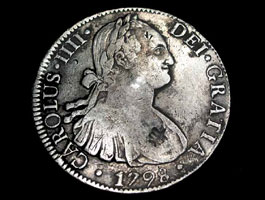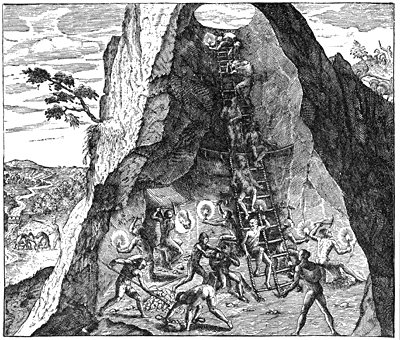China and Europe: 1500-1800
The Silver Trade, Part 2
During this period when silver was flowing to China, the Mexican peso became the standard coin throughout much of the world. In some ways, it was the first global product with a brand name—"Mexican pesos," not "silver," was the preferred term for currency among many peoples.

Silver coin from Mexico with bust of Carols IV, minted 1798
asiannumismatic.com
Pesos were so familiar in China that they had cute little names for them. One of the kings of Spain, whose image was on the peso during his reign, looked to the Chinese like Buddha, so they referred to this as the "Fat Buddha" coin or the "Buddha Head" coin. And they were so used to this that, in fact, they drove world demand for this particular coin. Long after this particular Spanish king was dead, other people discovered that the Chinese wanted coins with this particular image on them, so the price of the coins rose.
As a result, people such as the Dutch were making coins with the face of a particular long-dead Spanish king on them because the Chinese wanted them. (Much as people today make fake Prada handbags to satisfy consumer demand.) The Chinese market for coins, essentially, set the global standard. These coins were also so common in China that land contracts normally had a price in copper or some local medium, and then in a little handwritten note on the side next to the standard price, they told you how much that was in Spanish or Mexican pesos. It was just a part of life there.
The Columbian Exchange and Asia
The silver trade really, in certain fundamental ways, brought the world together in a way it never had been before.

Mexican silver mine (c. 1600).
North Wind Picture Archives
In preindustrial conditions, there aren't very many goods that are so valuable per pound that they're worth shipping huge distances. So it takes luxury goods—things like silver and silk—to make the long distance voyage profitable. You never would have made the voyage if what you had to sell was just grain or lead or whatever because it wouldn't have been worth it. It's not worth enough per pound to bear the shipping costs.
But once you're going anyway, all sorts of other things go with you. Goods go because you need ballast in the boat. Crop varieties go, too. Part of the story of the early modern world is also what has been called the Columbian exchange, in which all these New World plants that had not been known in Africa and Eurasia came to the Old World as a result of the European conquest of Latin America. We tend to emphasize the story of Europe; it's the story we know best, but those things came to Asia as well. Crops like the potato, the sweet potato, the peanut, corn, the chili pepper, the tomato, et cetera were tremendously important. Just try to imagine Italian cuisine without the tomato or Sichuan food without the chili pepper.

Corn from the New World was introduced into China
© North Wind Picture Archives

Sweet potatoes, one of the New World crops introduced into China
© North Wind Picture Archives
All these things came to Asia as well as to Europe and, in fact, in some cases, they were actually adopted faster in East Asia than they were in most of Europe. And they fit very particular ecological niches that were quite important. The potato, the sweet potato, corn, the peanut, all made it to China by 1600, on a very small scale, but they really took off in the eighteenth century.